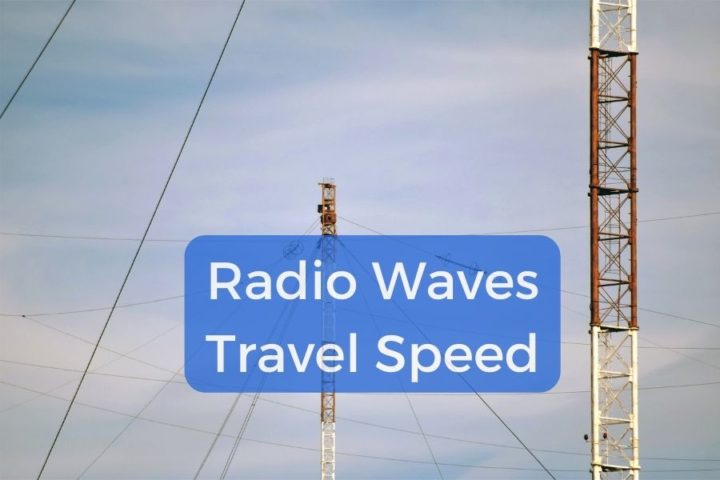How fast do radio waves travel in space?
The speed of radio waves in space is exactly the speed of light, which is about 300,000,000 meters per second.
Do radio waves travel at the speed of light?
Yes, Radio Waves travel at the speed of light.
The Speed of Radio Waves in Space
On a clear night, you can see thousands of stars when looking up at the sky. Regardless of how vast the sky feels to your eyes, what you see is only a tiny portion of the electromagnetic spectrum – the whole range of different light waves that exist.
The electromagnetic spectrum includes infrared radiation, microwaves, ultraviolet radiation, X-rays, gamma rays, and radio waves, all of which travel at the speed of light – 299,792,458 meters per second.
Radio signals take 8 minutes to travel from the Earth to the Sun, and from 5 to 20 minutes to travel from the Earth to Mars. The time varies because planets are constantly moving, and this affects their distances.
If you’re interested in the history of radio waves, this video by NASA will help:
Additionally, don’t mistake radio waves for sound waves. Even though people say “listen to the radio”, what you hear is sound waves. You can’t see, hear, or feel radio waves.
Sound only travels at 343 meters per second. This means that in the time sound travels the length of a football field, radio waves can travel almost three rounds around the Earth. Plus, radio waves travel in a vacuum, while sound waves can’t.
How Radio Waves Help With Space Exploration
1. Communication between spacecraft and the Earth
Have you ever wondered how spacecraft communicate with the Earth? When a spacecraft send out a message, it travels through space as radio waves.
The waves will become weaker when they get close to Earth. Thus, NASA must equip huge radio receivers that are aimed precisely to gather the radio waves from space. This process is similar to when stations send out radio signals, and you receive them with a radio tuner.
On Earth, NASA has to aim transmissions toward the spacecraft to send a message back. Each spacecraft has a radio wave transmitter and receiver, so astronauts can hear or read the message after the radio waves travel through space.
- TrendzGuruji.me Cyber, Health and Digital Updates
- Deltawifi.com Login: Access Delta onboard Wi-Fi
- Hyperverse Login at H5.thehyperverse.net
- TAFCOP Consumer Portal: Check Mobile Number Connections
- DotMovies: Watch Bollywood and Hindi dubbed movies
2. Radio telescopes
Radio telescopes have helped enhance our perception of the universe for decades.
Matters and phenomena in space are not always visible to human eyes. If you tune a radio telescope to 408 Hz and look at the sky, it will appear vastly different. Instead of bright lights of the stars, you will see distant pulsars, supernova remnants covering the sky, and even the birth of a new star.
Radio telescopes can also detect changing magnetic fields of other planets. They show us the gas and dust that swirl around Uranus and Neptune, upcoming comets, and how they move.
When astronomers continue to look farther with radio telescopes, they can see much more into the universe, such as black holes and the details of dark energy.
3. Sending messages into the Universe
Scientists have been transmitting radio waves into space for over 100 years. Our signals have passed more than 1,000 stars. Anyone orbiting the nearby stars with a good receiver could have detected the signals and know that we were here.
Although it is controversial whether scientists should try to talk to aliens or not, we can’t deny the significant role radio waves play in human civilization.
1. Do radio waves dissipate?
Yes, they do. When traveling long distances or bouncing back from obstacles, radio waves dissipate. After three to four bounces, radio signals will be weaker than the background noise at that frequency. The signal will then fade into the background. This happens even with powerful transmitted signals.
2. How do the waves work when I listen to the radio?
Stations transmit radio waves into the air. Then, when you tune the radio to your favorite station, the tuner receives the signals and vibrates the speaker, converting them to the sound waves you hear.
3. How fast do radio waves travel to the moon?
The speed of radio waves in meters per second is approximately 300,000,000. The average distance between Earth and the Moon is 384,400,000 meters.
Thus, it takes only over a second for radio waves to travel the distance. But the time can be longer than expected (from 2.4 to 2.7 seconds) due to echo delay.
4. How fast do radio waves travel in the atmosphere?
Radio waves travel at nearly that same speed when they are in the atmosphere. But they slow down when they travel through obstacles, conductors, waveguides, and circuits.
Conclusion
How fast do radio waves travel in space? Radio wave speed is approximately 300,000,000 meters per second. It travels in a vacuum at the speed of light, which is the highest velocity that exists.
The discovery of radio waves has opened up a new era of space exploration. These waves break the limits of distance communications and observations.
Share your thoughts with us in the comment section. Will mankind invent particles that beat the speed of radio waves?
